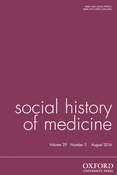-
Views
-
Cite
Cite
Adele Oltman, Tanya Hart, Health in the City: Race, Poverty, and the Negotiation of Women’s Health in New York City, 1915–1930, Social History of Medicine, Volume 29, Issue 3, August 2016, Pages 649–650, https://doi.org/10.1093/shm/hkw031
Close - Share Icon Share
Extract
In Health in the City , Tanya Hart investigates publicly-funded and privately administered infant and maternal health care that was ‘simultaneously racialized and cutting-edge’ (p. 3). The study begins in 1915, the year New York City’s Department of Health issued its first city-wide mortality study. Using the records of the New York Association for Improving the Condition of the Poor (AICP), Hart explores the introduction of nursing services and health education for pregnant women and new mothers in two poor and working-class immigrant communities.
She begins with Columbus Hill, a racially segregated and impoverished section on the city’s west side. As the first stop for many black newcomers from the British West Indies and the American South, it had one of the highest infant mortality and maternal morbidity and mortality rates in the city. The social and political context of the AICP’s ‘maternalism’ was eugenics and social Darwinism that proffered pseudo-scientific racialised understandings of disease and inferiority. In an important discussion of how health data were racialised, Hart shows how the AICP justified shifting its original focus from eradicating tuberculosis and infant diarrhoeal diseases to maternal and congenital syphilis nine months after beginning its work in Columbus Hill. This reflected a commonly-held notion among white physicians and scientists that black people were a ‘syphilis-soaked race’ (p. 147). It also illustrates a Progressive Era tension between scientific understandings of germ theory and racialist dogmas.




